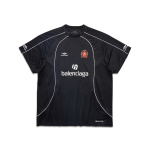
Football jerseys are the new sneakers
Is streetwear back as blokecore?
October 8th, 2024
Sold out after sold out, continuous retail price increases, a growing presence in users' Instagram feeds, and simultaneously on runways at Fashion Weeks around the world. There is no doubt that football shirts are now a garment in continuous growth, both in terms of quantity and cultural relevance, making it important to analyze the evolution of their social impact. For all the observable similarities, it can be stated with some certainty that the success of football shirts mirrors that of sneakers during the renowned 2017-2020 period, a phenomenon that, however, saw a rapid and inevitable decline shortly after. In addition to the previously mentioned reasons, there are other factors that allow for a parallel between two worlds that may seem distant but aren't so far apart. Among these is the parodic and increasingly "out of context" nature that football shirts are taking on. Like it or not, Travis Scott's arrest while wearing Juventus goalkeeper Antonio Chimenti’s jersey is a key symbol for understanding the "second youth" that football shirts are currently experiencing.
The fact that one of the world’s most influential artists was arrested in front of the entire world wearing the shirt of a relatively unknown Serie A goalkeeper is a clear sign that we are only seeing the tip of the iceberg: a speculative bubble of enormous proportions, perhaps more advanced than we might imagine. The next step for football shirts will be their transformation into a sort of mask, a carnival-like costume. This phenomenon shows how more and more people are choosing to wear football shirts to tone down and make everyday looks less serious. If you recall when the internet was flooded with memes mocking men over 30 who paired Jordan 1 Highs with formal wedding attire, the context hasn’t changed much. Today, the star is different: it used to be sneakers, now it’s football shirts. Several events highlight the difference between today and yesterday, especially at a perceptual level.
Sold out and sky-high retail
It’s striking to see an item like this unavailable on the website where it’s sold. This past summer, just under a week before the start of Euro 2024, the German national team Away jersey by adidas sold out in every store and e-commerce site, including those of the Three Stripes, the team’s technical sponsor. It was even a record: no Away jersey had ever sold out so quickly. Yet, when the jersey was unveiled in March, it was heavily criticized, to which the German Football Federation immediately responded. A more recent case also involves the Three Stripes brand. Juventus' third kit for the 2024/25 season, one of the most coveted among those released between May and September 2024, is sold out both on the adidas website and the club’s site. In short, it’s practically unavailable, and while we await confirmation on whether supply chain issues have contributed to the scarcity, the shock of an item being unavailable brings to mind the difficulties of purchasing an adidas Yeezy 350 or one of the models from the Nike x Off-White "The Ten" collection.
@juventus Third kit shooting backstage @adidas #jersey #juventus #yildiz #bts Trendsetter - Connor Price & Haviah Mighty
Especially since it's unusual for a football shirt to sell out: the last time this happened was after Argentina’s victory at the 2022 World Cup in Qatar, with the iconic Albiceleste jersey featuring Lionel Messi's number 10 selling out shortly after the trophy win—it’s still available on StockX at prices ranging between €300 and €450 for the Authentic version. With the now widespread popularity of Bloke core, football shirts are more likely to sell out, as buyers are eager to own them and incorporate them into their weekly wardrobe rotations—not necessarily for playing in their usual Thursday night five-a-side matches with friends. This isn’t just about rising prices on the secondary market but also in retail. Just over a year ago, Footy Headlines predicted that football shirt retail prices would increase by 5-14%: looking at adidas and Nike, it now costs €100 to purchase a team’s Replica jersey and €150 for the Authentic version, which typically features more details, making it particularly appealing for those looking to integrate it into a lifestyle styling.
Collecting and the vintage universe
There are evident similarities between the sneaker collecting world and that of football shirts, but also key differences. The sneaker boom coincided with the rise of platforms that fueled the secondary market, such as StockX, followed by K'lekt, GOAT, and Grailed. However, in the football shirt world, no large companies operate exactly like StockX. This is because the American marketplace, founded in 2016, primarily focuses on new items, while this dynamic is less developed in football shirts, except for a few cases like Juventus' or Argentina's 2022 shirts. It remains unclear whether a similar model will take hold in the football shirt market. The leader in the football shirt boom is Classic Football Shirts, which has been a point of reference for buying and renting vintage and rare shirts since 2006. While the e-commerce of major sports brands remains the primary alternative for purchasing official club merchandise, Classic Football Shirts has quickly established itself as a "phygital" space par excellence, combining pop-up stores with e-commerce.
The changes in the industry and the communities
Obvious yet understandable, the boom in the soccer jersey market has greatly transformed the scope of various players in the sportswear and athletic wear industry, consequently influencing their strategies. Take Foot Locker as an example. This athletic apparel retailer has established itself over time as a true institution in the world of sportswear, importing NBA jerseys and MLB snapbacks into Europe, and has recently begun selling football items. For years, it was the primary destination for purchasing Nike sneakers and contributed between 26% and 28% of Nike’s total revenue in the United States, especially in the early 2000s; Nike, in turn, accounted for more than half of Foot Locker’s total sales at the beginning of the century. Now that sneakers can no longer function as a "cash cow" for Foot Locker, the focus shifts to football jerseys, items that by nature wouldn’t belong to the heritage of one of the most famous retailers of all time. Yet, even - and especially - Foot Locker demonstrates how these jerseys have become the object of desire today.
The unexpected excitement surrounding this niche market has allowed countless communities to emerge and find a free space for expression. Here too, we can trace another similarity to the sneaker craze of a few years ago. Whereas in the past, the places for showcasing questionable outfits, featuring Supreme ski masks and Off-White crewnecks, were varied, today these communities have moved to Instagram, a platform that is more immediate and in tune with the times. Here, outfits featuring football shirts are showcased in the most bizarre contexts, from music festivals (which have maintained their identity in this regard) to Fashion Weeks. While it is difficult to predict the future of football shirts, especially in terms of perception, it is crucial to consider that just as sneakers became closely tied to hypebeast aesthetics, football shirts have launched the bloke core trend, which is rapidly advancing and poised to break away from the traditional football shirt form—the most important lesson we've learned from the recently concluded Fashion Weeks.












